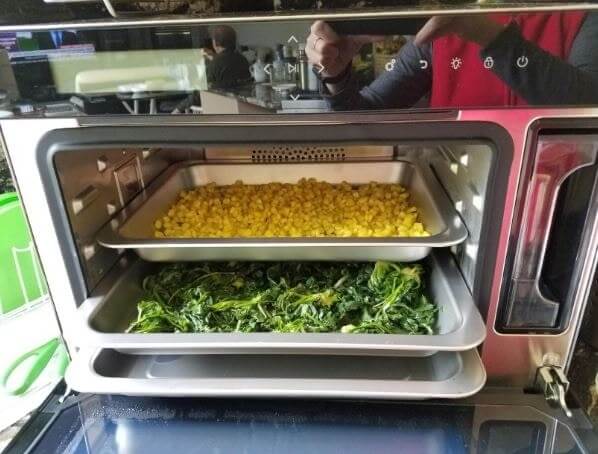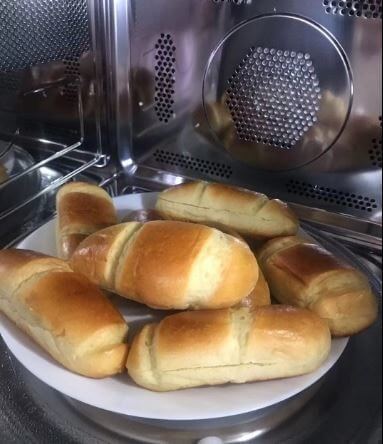Just like with any other innovation, cooking technology is always evolving. Fortunately, we’re cooking in a time where manufacturers are able to offer the best oven technology through steam and convection ovens.
When thinking about your cooking preferences and steam oven vs. convection oven, you need to know how each appliance works.
In this post, we compare steam and convection ovens to help you get the best model for you.
A Comparison Table to Help You Choose Between a Steam or Convection at a Glance
| Feature | Steam Oven | Convection Oven |
|---|---|---|
| Heating Method | Uses steam to heat food | Uses hot air to heat food |
| Size | A little big(takes a lot -of counter space) | Available in different sizes |
| Risk of burning | Less risk of burning | High chances of overcooking or getting your food burnt. |
| Cooking time | Very fast | Fast |
| Performance | Cooks food without removing healthy nutrients and vitamins | Browns food evenly and perfect for making crispy meals |
| Price | Expensive | Fairly priced |
Steam Ovens

A steam oven uses steam instead of hot air to cook food. When you cook with this oven, the food is evenly cooked in a moist environment and thus can’t dry out.
Cooking in a steam oven minimizes the reliance on oils and fats, which lowers the intake of bad calories and cholesterol. The results are healthier and tastier food.
Steam ovens can cook delicate dishes to perfection without the associated drying that ruins croissants, bread, and pastries.
How do Steam Ovens Work?
Steam ovens come with a water canister in the oven’s cavity. Water is injected into the boiler via a pump, and the heat from this oven turns the water into steam.
It’s this hot steam that cooks food evenly.
Cheaper steam ovens require the manual filling of a water trough or tray that is then placed in the oven. Premium models are the easiest to use; You just need to connect the oven to a water line.
Steam cooking keeps your food’s moisture at optimal levels reducing the need for fats, oils, and seasonings.
Advantages of a Steam Oven
Healthy Cooking
Using steam instead of hot air to cook helps reduce the loss of nutrients in your food. Also, steam-cooking tends to lock nutrients and vitamins in your food, unlike hot air, which significantly lessens essential nutrients in your food due to overcooking.
And unlike what most people tend to think, steam cooking doesn’t entail boiling your food in the water. Boiling vegetables and other foods lead to the seeping of nutrients and vitamins in the water.
Also, with a steam oven, you won’t have to use a lot of oil or fat to cook your food.
Food Tastes Better
One of the selling points of steam ovens is that these appliances cook food without compromising on taste. The units allow you to cook food without drying it.
And remember, limited nutrients get destroyed when steam-cooking hence the better taste.
Faster Cooking Time
Although convection ovens cook at higher temperatures than steam ovens, the latter cooks faster. This is simply because steam transfers heat faster and more efficiently than air.
Expect to cook, on average, 30% faster with a steam oven than when using a convection oven. This will, however, depend on the food you’re cooking.
Cooks a Variety of Dishes
With a steam oven, you can cook various healthy foods, including vegetables, chicken, curries, pasta, rice, soup, and others.
And if you’re lucky enough to own a combination steam oven, you can steam, roast, and bake all your favorite dishes.
Can Cook Food Simultaneously
You can cook various foods simultaneously in a steam oven. And because of the design of these ovens, you won’t have to worry about the transfer of flavors between foods.
Warms Food Evenly
Steam-warming your food helps retain its flavor and moisture. The process provides better moisture retention as well, meaning that your food will remain juicy all through.
Lessens the Risk of Burning
The risk of overcooking your food is limited when steam cooking. The steam circulates evenly in the oven resulting in evenly cooked food.
Disadvantages of Steam Ovens
Takes a Lot of Space
If you have a small kitchen/limited kitchen space, a steam oven might not work for you. This is because these units take a lot of space, especially the countertop models. These take up more space than microwaves.
Require Regular Cleaning
Steam ovens require more often cleaning than regular ovens. This is because when cooking, condensation builds up.
To avoid unwanted taste or smell transferring to your food, you have to clean the unit after every use.
Not Suitable for All Food
With a regular steam oven, you can cook foods that require browning and crisping. Also, some delicate foods like pastries and cakes can’t handle the steam in the oven.
However, you can purchase a combination steam oven that enables you to enjoy the features of steam and regular oven.
Expensive
Steam ovens come with a high price tag, especially those from top brands.
Convection Ovens
A convection cooks food using the circulation of hot air. It uses a fan to circulate heat throughout the oven.
The even distribution of heat translates to faster cooking times.
These ovens do more than just cook turkey or prepare pizza. They are used for non-food uses and industrial needs as well.
A convection oven helps remove the blanket of cold air surrounding food products when placed in the oven. This enables the unit to work at a lower temperature without increasing the cooking time.
How Does a Convection Oven Work?
A convection oven uses a built-in fan to circulate hot air and ensures good airflow when the oven is on. And because the airflow creates even heat distribution, it also provides faster cooking times and a drier environment that improves the texture of some dishes.
Items placed on the bottom or top of the rack will bake or cook at the same time and temperature, resulting in perfectly cooked meals.
Advantages of Convection Ovens

Cook Food Evenly
It isn’t uncommon for a conventional oven to be too hot and too cold in some areas. But this is never the case with convection ovens.
The built-in fan in convection ovens circulates hot air all over the oven to ensure that the temperature is the same throughout.
You won’t have to worry about getting some red patches in your meat after removing it from the oven with a convection oven. You’ll always get even results – perfectly cooked meat.
Cooks More Dishes at a Time
If you’re always hosting guests at your place, you’ll love having a convection oven around. It allows you to cook a number of dishes at a go!
You can even stack your dishes on top of each other, and they’ll still get cooked at the right temperature.
Shorter Cooking Times
As aforementioned, convection ovens cook evenly, which means that your food cooks from all sides simultaneously. As a result, you’ll get your meals to the table up to 20% faster.
If yours is one busy family, this oven comes in handy. You’ll also use less electricity to prepare meals, which translates to a reduction in your monthly power bill.
Food Comes Out with Crispier Textures
When you use a convection oven, your food will always brown better (when baking). And if you like French fries, roasted potatoes, or food that you’d normally fry, this oven will help you create a healthier version with a nice crunch.
Easy to Use
Convection ovens are quite easy to use. To get your food ready, all you need to do is place it in the unit, engage the settings and wait for it to get ready.
Disadvantages of Convection Ovens
Requires You to Adjust the Recipes
If you don’t adjust the recipes when using a convection oven, you’ll most likely end up with overcooked or burnt food. Baked foods such as cookies and bread are the most susceptible.
Are More Prone to Breaking Down
Convection ovens come with a heating element and a fan, features that make them more fragile. And although these units can last for years without issues, the extra parts might require repair at some point.
Cooking Too Many Dishes at Once can Hinder Performance.
While you can cook a variety of dishes in a convection oven at a go, overcrowding the unit can block the fan. With a blocked fan, the oven won’t work as effectively as it ought to.
Which Is Better, a Steam Oven or a Convection Oven?
Both models work great, and the best unit should be one that meets your household’s needs. What works for you may not work for another and vice versa.
Steam ovens provide reliable and excellent cooking results. These appliances even cook faster than convection ovens. They also offer you the healthiest option to cook as steam cooking retains more nutrients in your food.
Convection ovens are no joke as well. They help you cook faster, are the best for baking and preparing crispy delicacies, and are easy to use.
Frequently Asked Questions
i. Is a steam oven worth it?
Of course, yes. A steam oven enables you to not only prepare healthy meals but does so fast. With a steam oven, you can also prepare a variety of meals without compromising the food’s texture, flavor, and taste.
ii. Can one cook pizza in a steam oven?
If you get a combination steam oven, you can prepare a pizza with ease. This oven boasts the features of a steam oven and a convection oven hence highly functional.
iii. Do steam ovens require a water supply?
Most steam ovens are compact and smart. They come with a detachable water tank and don’t need to be connected to a water supply.
iv. What can one not cook in a convection oven?
Do not use convection for cooking custards, quick breads, or cakes. This is because the movement of air from the unit’s fan can cause them to rise less impressively.
Conclusion
The pros and cons of steam and convection ovens are essential to review if torn between the 2 models. We hope that this information will help you in your consideration of steam oven vs. convection and that you’ll get the unit that suits your family best.
